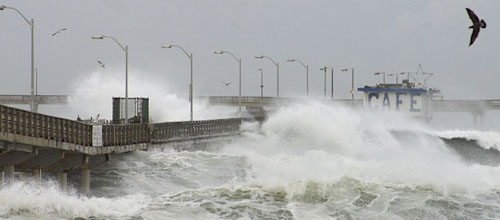| 2022 Sea Level Rise Technical Report; Section 3 Extreme Water Levels and Changing Coastal Flood Exposure | Sea level rise will create a profound shift in coastal flooding over the next 30 years by causing tide and storm surge heights to increase and reach further inland. By 2050, “moderate” (typically damaging) flooding is expected to occur, on average, more than 10 times as often as it does today, and can be intensified by local factors. | 2022 |
| Inequitable patterns of US flood risk in the Anthropocene | Current flood risk mapping, relying on historical observations, fails to account for increasing threat under climate change. Incorporating recent developments in inundation modelling, here we show a 26.4% increase in US flood risk by 2050 due to climate change alone. Our national depiction of comprehensive and high-resolution flood risk estimates in the US indicates current average annual losses of $32.1 billion in 2020’s climate, which are borne disproportionately by poorer communities with a proportionally larger White population. The future increase in risk will disproportionately impact Black communities, while remaining concentrated on the Atlantic and Gulf coasts. Furthermore, projected population change could cause flood risk increases that outweigh the impact of climate change fourfold. These results make clear the need for adaptation to flood and emergent climate risks in the US, with mitigation required to prevent the acceleration of these risks. | 2022 |
| IPCC Report, the Physical Science Basis of Climate Change: Chapter 11: Weather and climate extreme events in a changing climate | This chapter assesses changes in weather and climate extremes on regional and global scales, including observed changes and their attribution, as well as projected changes. The extremes considered include temperature extremes, heavy precipitation and pluvial floods, river floods, droughts, storms (including tropical cyclones), as well as compound events (multivariate and concurrent extremes). | 2021 |
| Explaining Extreme Events of 2016 from a Climate Perspective | Extreme weather event types in this year’s report include ocean heat waves, forest fires, snow storms, and frost, as well as heavy precipitation, drought, and extreme heat and cold events over land. There were a number of marine heat waves examined in this year’s report, and all but one found a role for climate change in increasing the severity of the events. In this report, 21 of the 27 papers in this edition identified climate change as a significant driver of an event, while 6 did not. Of the 131 papers now examined in this report over the last six years, approximately 65% have identified a role for climate change, while about 35% have not found an appreciable effect. | 2018 |
| WMO Statement on the State of the Global Climate in 2017 | There were many significant weather and climate events in 2017, including a very active North Atlantic hurricane season, major monsoon floods in the Indian subcontinent, and continuing severe drought in parts of east Africa. This contributed to 2017 being the year with the highest documented economic losses associated with severe weather and climate events. Extreme weather events continue to be rated by the World Economic Forum as among the most significant risks facing humanity, both in terms of likelihood and impact. | 2018 |
| Precipitation Change in the United States; Chapter 7 from the Fourth National Climate Assessment (NCA4), Volume I | Changes in precipitation are one of the most important potential outcomes of a warming world because precipitation is integral to the very nature of society and ecosystems. These systems have developed and adapted to the past envelope of precipitation variations. Any large changes beyond the historical envelope may have profound societal and ecological impacts.
Historical variations in precipitation, as observed from both instrumental and proxy records, establish the context around which future projected changes can be interpreted, because it is within that context that systems have evolved. Long-term station observations from core climate networks serve as a primary source to establish observed changes in both means and extremes. Proxy records, which are used to reconstruct past climate conditions, are varied and include sources such as tree ring and ice core data. Projected changes are examined using the Coupled Model Inter- comparison Project Phase 5 (CMIP5) suite of model simulations. They establish the likelihood of distinct regional and seasonal patterns of change. | 2017 |
| Extreme Storms Chapter 9 from the Fourth National Climate Assessment (NCA4), Volume I | Extreme storms have numerous impacts on lives and property. Quantifying how broad- scale average climate influences the behavior of extreme storms is particularly challenging, in part because extreme storms are comparatively rare short-lived events and occur within an environment of largely random variability. Additionally, because the physical mechanisms linking climate change and extreme storms can manifest in a variety of ways, even the sign of the changes in the extreme storms can vary in a warming climate. This makes detection and attribution of trends in extreme storm characteristics more difficult than detection and attribution of trends in the larger environment in which the storms evolve (e.g., Ch. 6: Temperature Change). Projecting changes in severe storms is also challenging because of model constraints in how they capture and represent small-scale, highly local physics. Despite the challenges, good progress is being made for a variety of storm types, such as tropical cyclones, severe convective storms (thunderstorms), winter storms, and atmospheric river events. | 2017 |
| Attribution of Extreme Weather Events in the Context of Climate Change | This report examines the current state of science of extreme weather attribution, and identifies ways to move the science forward to improve attribution capabilities. The science of extreme event attribution seeks to tease out the influence of human-caused climate change from other factors as contributors to individual extreme events. As climate has warmed over recent years, a new pattern of more frequent and more intense weather events has unfolded across the globe. Climate models simulate such changes in extreme events, and some of the reasons for the changes are well understood. Warming increases the likelihood of extremely hot days and nights, favors increased atmospheric moisture that may result in more frequent heavy rainfall and snowfall, and leads to evaporation that can exacerbate droughts. Event attribution can answer questions about how much climate change influences the probability or intensity of a specific type of weather event. | 2016 |

